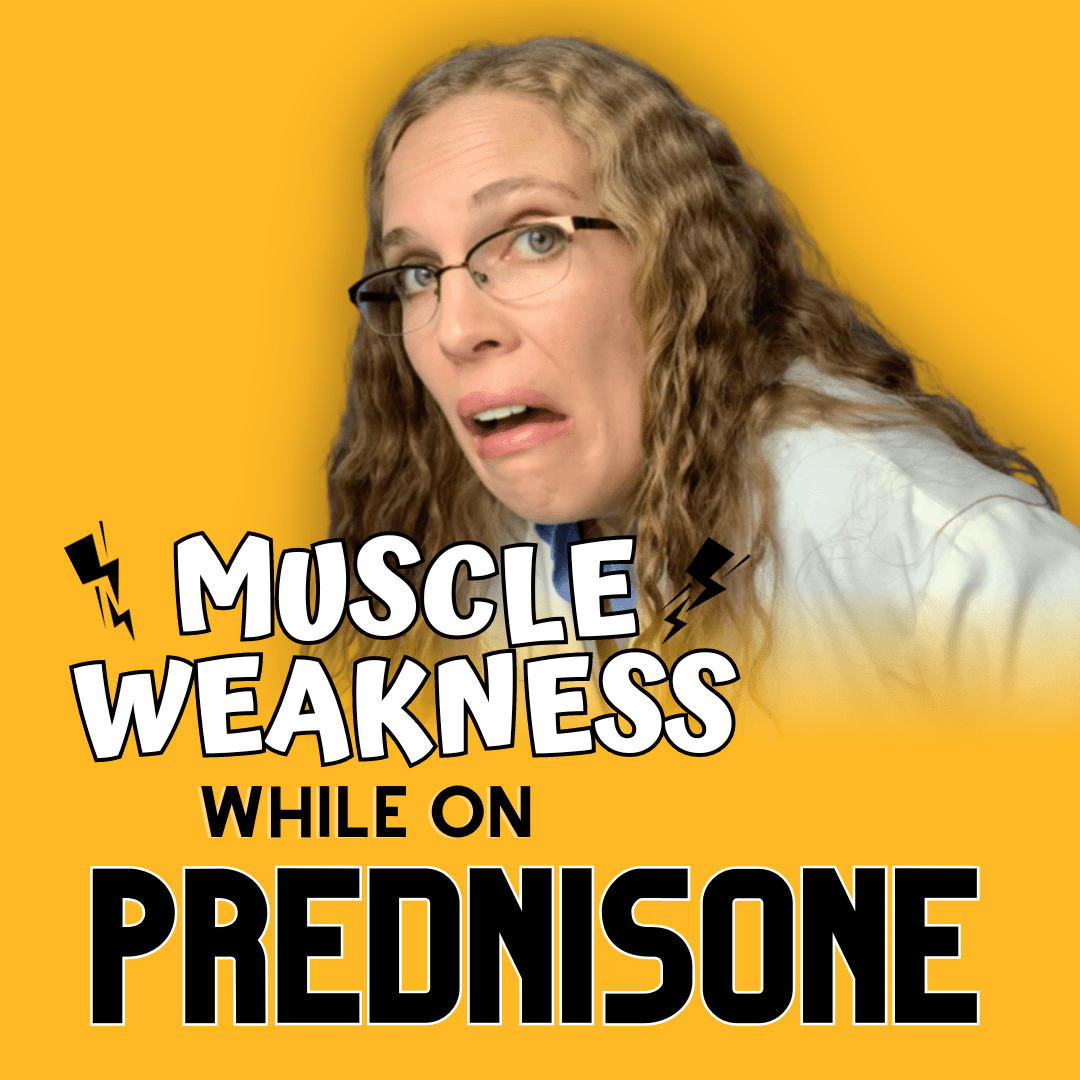Muscles Hurting & Weakening While on Prednisone?

A Prednisone Warrior asked about how prednisone can affect muscles:
So I’ve been on Prednisone daily without fail for 13 years due to a neuromuscular disease, myasthenia gravis. I definitely feel my joints and muscles hurting, weakening and sometimes seem like they are shrinking even. Is this normal for Prednisone and for this long on it? I’m only 42 so I have a long time left and hopefully I won’t be hurting the whole time due to joint pain.
Can prednisone cause aches and pains?
Yes, prednisone can cause aches and pains, from muscle pain to joint pain as side effects. It seems backward, since prednisone is often prescribed for aches and pains such as rheumatoid arthritis joint pain, but it can happen. Watch this video to see Dr. Megan explain that prednisone muscle pain, joint pain, and muscle weakness are legitimate side effects of prednisone
Watch now!
Is it normal for muscles to hurt, weaken, or shrink while on prednisone?
Yes, prednisone can cause muscle changes from muscle pain, to muscle weakness (myopathy), to muscle loss (muscle atrophy). Muscle pain could also be a symptom of prednisone withdrawal, so it’s hard to tell and best to discuss with your doctor. Extreme muscle damage is possible but rare. Since myopathy is the most common, we will focus on that for this article. The condition typically develops with doses higher than 10 mg prednisone equivalents/day used for four weeks or longer, though it’s possible with short-term very high doses.
What are the symptoms of myopathy from prednisone?
The main symptom is muscle weakness on both sides of the body, with most of the weakness in the hip muscles. Prednisone muscle weakness is most common in the legs. Typically the myopathy doesn’t cause pain (so muscle pain from prednisone is not myopathy). It slowly gets worse over time taking prednisone, and people might have a hard time rising from a seated position or taking the stairs. Doctors have to test to make sure it’s from prednisone and not another cause (see below).
How many people on prednisone get muscle weakness?
Corticosteroid-induced myopathy, the medical term for muscle weakness from prednisone, is the most common myopathy caused by a drug, with an incidence of 50% to 60% among those using corticosteroids for a prolonged period. It’s more common in the elderly, people with cancer, respiratory conditions, poor diet, and living a sedentary lifestyle. Women are more prone to this side effect than men. The condition typically develops with doses higher than 10 mg prednisone equivalents/day used for four weeks or longer.
How does prednisone cause muscle weakness?
Glucocorticoids like prednisone change how our bodies use protein. They alter protein metabolism. Prednisone slows down the making or building up of protein, which is called the anabolic path. However, the main way prednisone causes myopathy is by causing muscle breakdown, or catabolism. So prednisone is both breaking down muscles and slowing down the building of them back up.
Other causes of prednisone muscle issues could include changes in electrolytes (potassium and calcium) or other nutrient deficiencies like vitamin D. Prednisone depletes at least 9 nutrients, so the nutrient depletion could affect how muscles feel while on prednisone.
How do doctors treat prednisone myopathy?
Ideally, stop taking prednisone and see if the muscle weakness gets better in 3-4 weeks. However, most people can’t and shouldn’t do that because of the need for long-term steroid treatment, plus stopping prednisone suddenly can be fatal.
How long does it take to recover from prednisone myopathy?
If prednisone is stopped, recovery can take weeks, months or even a year.
What can I do to reverse or deal with prednisone muscle wearing?
- Angela asked, “I have severe muscle weakness from long term prednisone, I also have SAI. Is there any thing that I can do to rebuild the muscle loss?”
- Ryan asked, “Any thoughts on dealing with / mitigating muscle myopathy due to prednisone?”
- Jacob asked, “I was wondering if you had any advice on dealing with or avoiding some of the muscle wearing caused by prednisone?”
To answer these three prednisone warriors’ questions, I can offer three possible solutions. First exercise, then diet, and finally nutrient replenishment.
Exercise is effective for both prevention and treatment of muscle changes from prednisone. A study showed that physical therapy with resistance exercise is effective for muscle atrophy (wasting) and muscle weakness (myopathy). Another study showed that aerobic physical training can reverse “glucocorticoid-induced muscle wasting… in patients taking a low to moderate dose of prednisone.” Definitely work with a doctor or physical therapist if you’re just starting exercise again.
Eating a diet with enough protein makes sense, but there are no studies showing that it definitely helps yet.
To prevent muscle changes caused by nutrient depletion (of potassium, calcium, and vitamin D), you can replenish these nutrients depleted. Eating a diet high in these nutrients is the best first way. It can be pretty hard to eat a high-potassium and high-vitamin D diet, so often supplementation is needed to get these nutrients into your body. Nutranize Zone is the first and only supplement designed to help you reduce your suffering by replenishing your nutrients so that you can recover from taking prednisone. It contains potassium, calcium, vitamin D and 14 other vital nutrients for people on prednisone.
You can find it at Nutranize.com
References:
- Surmachevska N, Tiwari V. Corticosteroid Induced Myopathy. [Updated 2023 Apr 17]. In: StatPearls [Internet]. Treasure Island (FL): StatPearls Publishing; 2023 Jan-. Available from: https://www.ncbi.nlm.nih.gov/books/NBK557731/
- Gupta A, Gupta Y. Glucocorticoid-induced myopathy: Pathophysiology, diagnosis, and treatment. Indian J Endocrinol Metab. 2013 Sep;17(5):913-6. doi: 10.4103/2230-8210.117215. PMID: 24083177; PMCID: PMC3784879.
- Braith RW, Welsch MA, Mills RM Jr, Keller JW, Pollock ML. Resistance exercise prevents glucocorticoid-induced myopathy in heart transplant recipients. Med Sci Sports Exerc. 1998 Apr;30(4):483-9. doi: 10.1097/00005768-199804000-00003. PMID: 9565927.
- Horber FF, Scheidegger JR, Grünig BE, Frey FJ. Evidence that prednisone-induced myopathy is reversed by physical training. J Clin Endocrinol Metab. 1985 Jul;61(1):83-8. doi: 10.1210/jcem-61-1-83. PMID: 3998075.
- Webster JM, Fenton CG, Langen R, Hardy RS. Exploring the Interface between Inflammatory and Therapeutic Glucocorticoid Induced Bone and Muscle Loss. Int J Mol Sci. 2019 Nov 16;20(22):5768. doi: 10.3390/ijms20225768. PMID: 31744114; PMCID: PMC6888251.
For Further Reading:
Related Posts
-
Prednisone for Myasthenia Gravis
Prednisone is prescribed for more diseases and conditions than any other drug. Crazy, huh? One... -
Extreme Damage to Muscles from Prednisone – Muscle Weakness
Steve shares his prednisone journey with me of what terrible reaction he had experiencing prednisone... -
9+ Nutrients Depleted by Prednisone
Prednisone steals over nine critical nutrients from the body. This nutrient depletion is responsible for... -
Exercise and Prednisone – Is it safe? What if I’m stuck in bed?
Exercise and Prednisone Can I exercise with prednisone? Is it safe? What if I’m stuck... -
Steroids: The Good, the Bad, & the Ugly
This article is part of a series of stories of Prednisone Warriors sharing their experience...

